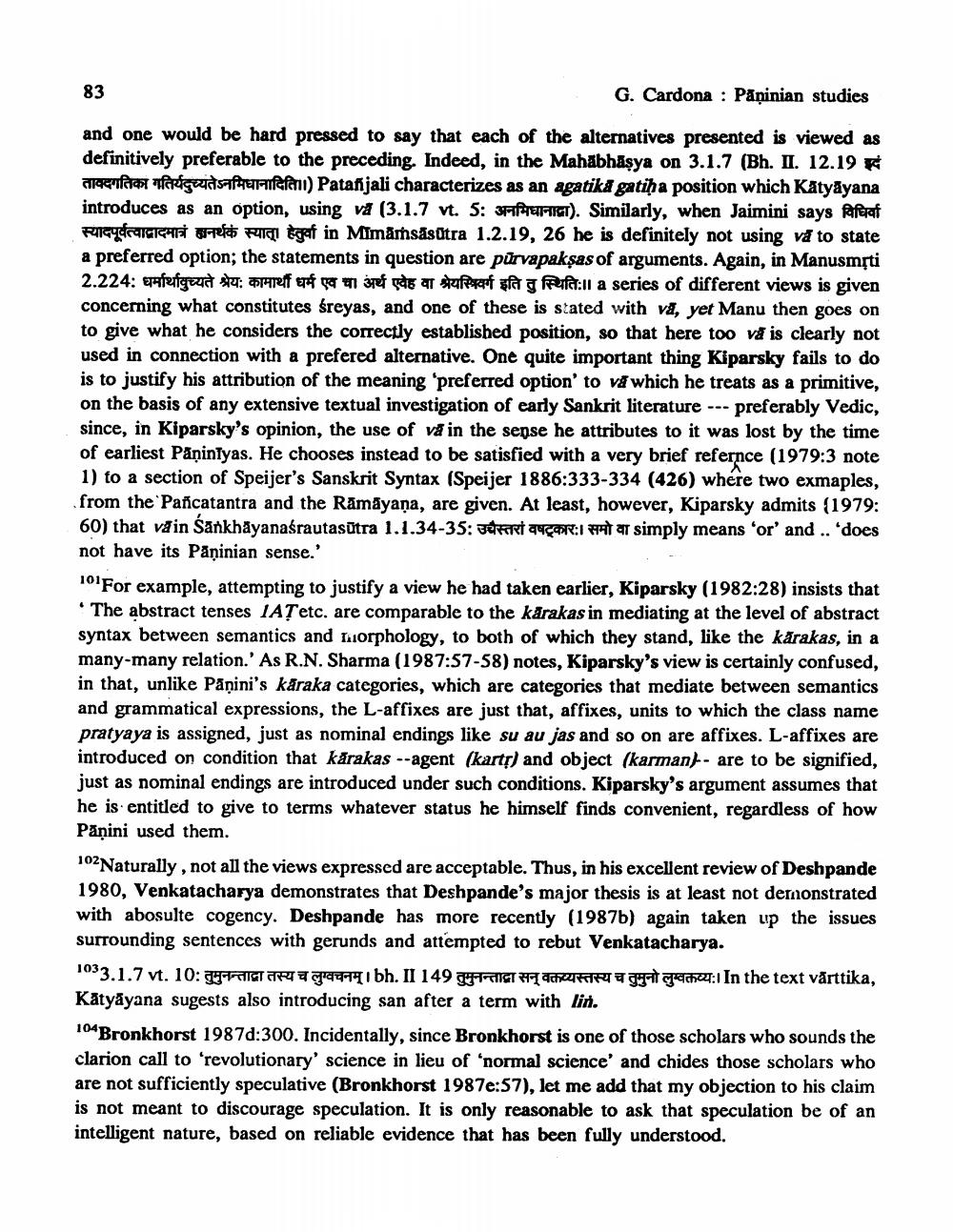________________
83
G. Cardona Păninian studies and one would be hard pressed to say that each of the alternatives presented is viewed as definitively preferable to the preceding. Indeed, in the Mahabhäṣya on 3.1.7 (Bh. II. 12.19
enfam fidget) Patanjali characterizes as an agatik gatiha position which Katyayana introduces as an option, using va (3.1.7 vt. 5: far). Similarly, when Jaimini says f Fagent wel gef in Mimämsäsütra 1.2.19, 26 he is definitely not using va to state a preferred option; the statements in question are parvapaksas of arguments. Again, in Manusmrti 2.224: धर्मार्थावुच्यते श्रेयः कामार्थी धर्म एव चा अर्थ एवेह वा श्रेयस्थिवर्ग इति तु स्थितिः॥ a series of different views is given concerning what constitutes śreyas, and one of these is stated with va, yet Manu then goes on to give what he considers the correctly established position, so that here too va is clearly not used in connection with a prefered alternative. One quite important thing Kiparsky fails to do is to justify his attribution of the meaning 'preferred option' to v which he treats as a primitive, on the basis of any extensive textual investigation of early Sankrit literature --- preferably Vedic, since, in Kiparsky's opinion, the use of val in the sense he attributes to it was lost by the time of earliest Panintyas. He chooses instead to be satisfied with a very brief refernce (1979:3 note 1) to a section of Speijer's Sanskrit Syntax (Speijer 1886:333-334 (426) where two exmaples, from the Pañcatantra and the Rāmāyaṇa, are given. At least, however, Kiparsky admits (1979: 60) that vain Sankhayanasrautasütra 1.1.34-35: daw simply means 'or' and.. 'does
not have its Paninian sense.'
101 For example, attempting to justify a view he had taken carlier, Kiparsky (1982:28) insists that 'The abstract tenses IAȚetc. are comparable to the kärakas in mediating at the level of abstract syntax between semantics and Lorphology, to both of which they stand, like the kärakas, in a many-many relation.' As R.N. Sharma (1987:57-58) notes, Kiparsky's view is certainly confused, in that, unlike Panini's kāraka categories, which are categories that mediate between semantics and grammatical expressions, the L-affixes are just that, affixes, units to which the class name pratyaya is assigned, just as nominal endings like su au jas and so on are affixes. L-affixes are introduced on condition that karakas--agent (karte) and object (karman)- are to be signified, just as nominal endings are introduced under such conditions. Kiparsky's argument assumes that he is entitled to give to terms whatever status he himself finds convenient, regardless of how Panini used them.
102Naturally, not all the views expressed are acceptable. Thus, in his excellent review of Deshpande 1980, Venkatacharya demonstrates that Deshpande's major thesis is at least not demonstrated with abosulte cogency. Deshpande has more recently (1987b) again taken up the issues surrounding sentences with gerunds and attempted to rebut Venkatacharya.
1033.1.7 vt. 10: तुमुनन्ताद्वा तस्य च लुग्वचनम् । bh. II 149 तुमुनन्ताद्वा सन् वक्तव्यस्तस्य च तुमुनो लुग्वक्तव्यः। In the text vārttika Katyayana sugests also introducing san after a term with lin.
104 Bronkhorst 1987d:300. Incidentally, since Bronkhorst is one of those scholars who sounds the clarion call to 'revolutionary' science in lieu of 'normal science' and chides those scholars who are not sufficiently speculative (Bronkhorst 1987e:57), let me add that my objection to his claim is not meant to discourage speculation. It is only reasonable to ask that speculation be of an intelligent nature, based on reliable evidence that has been fully understood.




